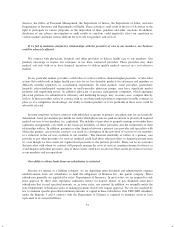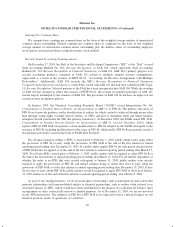Humana 2003 Annual Report Download - page 72
Download and view the complete annual report
Please find page 72 of the 2003 Humana annual report below. You can navigate through the pages in the report by either clicking on the pages listed below, or by using the keyword search tool below to find specific information within the annual report.
Humana Inc.
NOTES TO CONSOLIDATED FINANCIAL STATEMENTS—(Continued)
The preparation of financial statements in accordance with generally accepted accounting principles requires
us to make estimates and assumptions that affect the amounts reported in the financial statements and
accompanying notes. The areas involving the most significant use of estimates are the estimation of medical
expenses payable, the recognition of revenue related to our TRICARE contracts, the valuation and related
impairment recognition of investment securities, and the valuation and related impairment recognition of long-
lived assets, including goodwill. These estimates are based on knowledge of current events and anticipated future
events, and accordingly, actual results may ultimately differ materially from those estimates.
Cash and Cash Equivalents
Cash and cash equivalents include cash, time deposits, money market funds, commercial paper, other money
market instruments, and certain U.S. Government securities with an original maturity of three months or less.
Carrying value approximates fair value due to the short-term maturity of the investments.
Investment Securities
Investment securities, which consist primarily of debt securities, have been categorized as available for sale
and, as a result, are stated at fair value. Fair value of publicly traded debt and equity securities are based on
quoted market prices. Non-traded debt securities are priced independently by a third party. Fair value of venture
capital debt securities that are privately held, or where an observable quoted market price does not exist, are
estimated using a variety of valuation methodologies. Such methodologies include reviewing the value ascribed
to the most recent financing, comparing the security with securities of publicly traded companies in a similar line
of business, and reviewing the underlying financial performance including estimating discounted cash flows.
Investment securities available for current operations are classified as current assets. Investment securities
available for our professional liability and long-term insurance product funding requirements, as well as statutory
deposits and venture capital investments, are classified as long-term assets. Unrealized holding gains and losses,
net of applicable deferred taxes, are included as a component of stockholders’ equity until realized from a sale or
impairment.
For the purpose of determining gross realized gains and losses, the cost of investment securities sold is
based upon specific identification. We regularly evaluate our investment securities for impairment. We consider
factors affecting the investee, factors affecting the industry the investee operates within, and general debt and
equity market trends. We consider the length of time an investment’s fair value has been below carrying value,
the near term prospects for recovery to carrying value, and our intent and ability to hold the investment until
maturity or market recovery is realized. If and when a determination is made that a decline in fair value below
the cost basis is other than temporary, the related investment is written down to its estimated fair value through
earnings.
We participate in a securities lending program to maximize investment income. We loan certain investment
securities for short periods of time in exchange for collateral, consisting of cash or U.S. Government securities,
equal to at least 102% of the fair value of the investment securities on loan. The fair value of the loaned
investment securities is monitored on a daily basis, with additional collateral obtained or refunded as the fair
value of the loaned investment securities fluctuates. The collateral is deposited by the borrower with an
independent lending agent, and retained and invested by the lending agent according to our investment guidelines
to generate additional investment income. Loaned securities continue to be carried as investment securities on the
consolidated balance sheets.
64
























